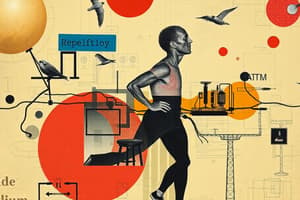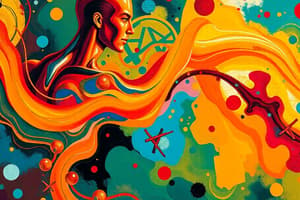Podcast
Questions and Answers
Which biochemical pathway is primarily responsible for the immediate source of ATP during intense exercise?
Which biochemical pathway is primarily responsible for the immediate source of ATP during intense exercise?
- Glycolysis
- Phosphocreatine breakdown (correct)
- Krebs cycle
- Oxidative phosphorylation
What is the net gain of ATP molecules produced by glycolysis?
What is the net gain of ATP molecules produced by glycolysis?
- 4 ATP
- 1 ATP
- 3 ATP
- 2 ATP (correct)
Which enzyme is considered rate-limiting in the glycolysis pathway?
Which enzyme is considered rate-limiting in the glycolysis pathway?
- Pyruvate kinase
- Hexokinase
- Phosphofructokinase (correct)
- Creatine kinase
How does the efficiency of glycolysis compare to other ATP production pathways?
How does the efficiency of glycolysis compare to other ATP production pathways?
What happens during the energy investment phase of glycolysis?
What happens during the energy investment phase of glycolysis?
Which statement correctly describes anaerobic ATP production?
Which statement correctly describes anaerobic ATP production?
What is the role of ATPase in energy metabolism?
What is the role of ATPase in energy metabolism?
Which of the following statements accurately describes the relationship between aerobic and anaerobic ATP production?
Which of the following statements accurately describes the relationship between aerobic and anaerobic ATP production?
What is the primary role of NADH in cellular respiration?
What is the primary role of NADH in cellular respiration?
How many molecules of ATP are produced from one molecule of NADH during the electron transport chain?
How many molecules of ATP are produced from one molecule of NADH during the electron transport chain?
What does the Krebs cycle primarily generate for the electron transport chain?
What does the Krebs cycle primarily generate for the electron transport chain?
During short-term high-intensity activities, which energy systems contribute more to ATP production?
During short-term high-intensity activities, which energy systems contribute more to ATP production?
What is the effect of high levels of ATP on ATP production?
What is the effect of high levels of ATP on ATP production?
Which molecule must pyruvic acid be converted into for entry into the Krebs cycle?
Which molecule must pyruvic acid be converted into for entry into the Krebs cycle?
What happens to hydrogen ions produced in the Krebs cycle within the mitochondria?
What happens to hydrogen ions produced in the Krebs cycle within the mitochondria?
Which molecule does FADH2 generate in the electron transport chain?
Which molecule does FADH2 generate in the electron transport chain?
What is a rate-limiting enzyme?
What is a rate-limiting enzyme?
Where does oxidative phosphorylation occur?
Where does oxidative phosphorylation occur?
Flashcards
What is ATP?
What is ATP?
ATP is a molecule that serves as the primary energy currency of cells. It consists of adenine, ribose, and three phosphate groups. Energy is released when one of the phosphate groups is removed, converting ATP to ADP.
What is the phosphocreatine system?
What is the phosphocreatine system?
The phosphocreatine system is an anaerobic energy system that provides a quick burst of energy by converting phosphocreatine (PC) to creatine (C) and releasing energy that is used to rephosphorylate ADP to ATP.
What is glycolysis?
What is glycolysis?
Glycolysis is an anaerobic process that breaks down glucose into pyruvate, producing a small amount of ATP (a net gain of 2 ATP molecules). It can occur without oxygen.
What is the Krebs cycle?
What is the Krebs cycle?
Signup and view all the flashcards
What is oxidative phosphorylation?
What is oxidative phosphorylation?
Signup and view all the flashcards
What are rate-limiting enzymes?
What are rate-limiting enzymes?
Signup and view all the flashcards
How do anaerobic and aerobic pathways differ?
How do anaerobic and aerobic pathways differ?
Signup and view all the flashcards
How do anaerobic and aerobic ATP production work together during exercise?
How do anaerobic and aerobic ATP production work together during exercise?
Signup and view all the flashcards
Hydrogen and Electron Carriers
Hydrogen and Electron Carriers
Signup and view all the flashcards
NAD (Nicotinamide Adenine Dinucleotide)
NAD (Nicotinamide Adenine Dinucleotide)
Signup and view all the flashcards
FAD (Flavin Adenine Dinucleotide)
FAD (Flavin Adenine Dinucleotide)
Signup and view all the flashcards
Oxidative Phosphorylation
Oxidative Phosphorylation
Signup and view all the flashcards
Electron Transport Chain (ETC)
Electron Transport Chain (ETC)
Signup and view all the flashcards
Rate-limiting Enzyme
Rate-limiting Enzyme
Signup and view all the flashcards
Anaerobic ATP Production
Anaerobic ATP Production
Signup and view all the flashcards
Aerobic ATP Production
Aerobic ATP Production
Signup and view all the flashcards
Anaerobic Energy System
Anaerobic Energy System
Signup and view all the flashcards
Aerobic Energy System
Aerobic Energy System
Signup and view all the flashcards
Study Notes
Energy Metabolism Overview
- Energy metabolism is the process of converting food into usable energy for cells.
- Food sources are broken down to be used by cells.
- Energy is transferred from food sources to ATP (adenosine triphosphate) via phosphorylation.
- ATP is a high-energy compound for storing and conserving energy.
- Muscle ATP stores are limited, requiring continuous re-synthesis to maintain physical activity.
Objectives
- Understand anaerobic ATP production pathways.
- Learn about aerobic ATP production.
- Analyze the interaction between aerobic and anaerobic ATP production during exercise.
- Identify rate-limiting enzymes in glycolysis and the Krebs cycle.
High-Energy Phosphates
- Adenosine triphosphate (ATP) consists of adenine, ribose, and three linked phosphates.
- ATP synthesis: ADP + P₁ → ATP
- ATP breakdown: ATP → ADP + P₁ + Energy (catalyzed by ATPase)
Bioenergetics
- Formation of ATP:
- Phosphocreatine (PC) breakdown
- Glycolysis (degradation of glucose/glycogen)
- Anaerobic pathways: Do not require oxygen; include PC breakdown and glycolysis.
- Aerobic pathways: Require oxygen; include oxidative phosphorylation.
Anaerobic ATP Production
- Phosphocreatine system (ATP-PC system): Immediate source of ATP; PC + ADP → ATP + C (catalyzed by creatine kinase)
- Glycolysis: Glucose breaks down into pyruvic acid or lactic acid.
- Energy investment phase (requires 2 ATP).
- Energy generation phase (produces 4 ATP, 2 NADH, and 2 pyruvate or 2 lactate).
Glycolysis Details
- Glycolysis regulates the whole pathway.
- Key enzymes like hexokinase and phosphofructokinase are crucial.
- Substrate-level phosphorylation occurs during glycolysis.
- The net gain is 2 ATP molecules.
- Glycolysis efficiency is 30%.
- Rapid energy transfer is a key function.
Hydrogen and Electron Carrier Molecules
- Transport H+ and electrons for ATP generation.
- NAD and FAD transfer H+ to mitochondria (aerobic).
- NAD + 2H+ → NADH + H+
NADH Shuttled to Mitochondria
- NADH generated in glycolysis must be converted back to NAD.
- Conversion to Lactic Acid is one method.
- 'Shutting' H+ into mitochondria is a mechanism.
The Krebs Cycle
- Degrades acetyl-CoA to CO₂ and hydrogen atoms.
- Hydrogens are oxidized in the electron transport chain.
- ATP is regenerated.
- Generates electrons (hydrogens) transferred to the electron transport chain via NAD+ and FAD.
Electron Transport Chain
- Oxidative phosphorylation occurs in mitochondria.
- Electrons from NADH and FADH₂ are passed to carriers (cytochromes).
- ATP is produced.
- Each NADH produces 2.5 ATP. -Each FADH₂ produces 1.5 ATP.
- H+ from NADH and FADH₂ are accepted by O₂ to form water.
Simplified ETC, and Aerobic ATP Production
- Electrons pass down a chain of carriers.
- Oxygen accepts the final electrons.
- This creates water.
The Krebs Cycle Summary
- Anaerobic glycolysis releases only 5% of glucose energy potential.
- Also known as the citric acid cycle, occurring in the mitochondrial matrix.
- Pyruvate is converted to Acetyl-CoA.
Relationship Between Protein, Carbohydrate, and Fat Metabolism
- Different macronutrients (proteins, carbohydrates, and fats) can enter the metabolic pathways at various points.
Control of Bioenergetics
- Rate-limiting enzymes control metabolic pathway speeds.
- Modulators, such as ATP/ADP levels, affect these enzymes, influencing ATP production.
Factors Affecting Rate-Limiting Enzymes
- Tables show known stimulators and inhibitors of rate-limiting enzymes in various energy pathways.
Interaction Between Aerobic/Anaerobic ATP Production
- Exercise energy comes from the interaction of these pathways, with relative contributions varying based on duration and intensity.
- High-intensity exercises rely more heavily on anaerobic systems.
- Low to moderate intensity exercises use aerobic systems more.
Contribution of Aerobic/Anaerobic ATP Production (During Specific Events)
- Graph shows percentages of aerobic or anaerobic contributions to ATP production during different sporting activities, based on duration and intensity.
Example Exam Questions (from Slides)
- This section covers examples of potential exam questions and associated definitions/principles. These are provided as a helpful summary of probable topic areas.
Studying That Suits You
Use AI to generate personalized quizzes and flashcards to suit your learning preferences.




